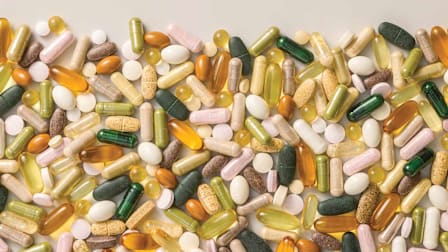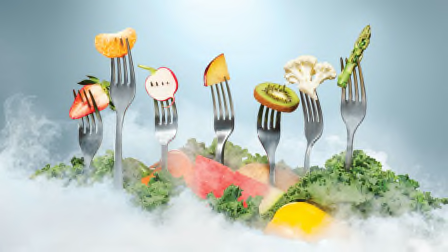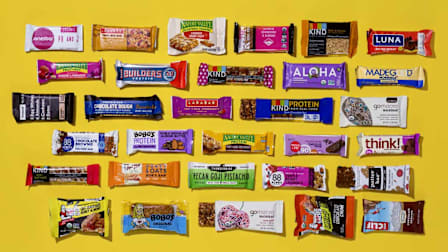A Guide to Healthy Portion Control
Serving up the right amounts can help you improve your diet and maintain a healthy weight

Many people assume some personal failing when they find it challenging to stick to a healthy diet. What we often forget, however, is that some of the most easily available, affordable foods are made with craveability in mind rather than nutrition. They’re also the ones most likely to be sold in oversized portions, says Lisa Young, PhD, RDN, an adjunct professor of nutrition at New York University.
Studies have shown that people tend to consume larger portions of less-than-healthy foods—think snack foods, desserts, and restaurant fare—and smaller helpings of healthier ones, such as whole grains and vegetables.
That has implications for weight, of course, especially for older adults. Metabolism slows with age, and calorie needs decrease as a result. This may lead to weight gain if you are still eating the same size portions you did 10 years ago.
What's a Portion?
That may seem like an obvious question, but a recent survey from the International Food Information Council found that only 45 percent of Americans define it correctly: the amount of food that you choose to eat, or are given to eat, at one time. About a third of those surveyed confused portion size with serving size. A serving is a standardized measure of food, set by the Food and Drug Administration, for use on Nutrition Facts labels.
This distinction matters because although serving sizes are based on typical consumption, individuals may need less—or more. The serving size isn’t a recommendation; it’s intended to convey information, Young says. People also may think they’re taking in the amount of calories and other nutrients for the serving listed on the label, when they may actually be getting more. For example, a serving of ice cream is set at ⅔ cup. If that serving has 330 calories and 19 grams of added sugars but you eat 1 cup, you’re downing about 500 calories and 29 grams of added sugars.
Why We Eat More Than We Think
Have you ever noticed that you tend to finish a plateful of food or a bag of cookies without really thinking much about how much you just ate? That may be because of something called “unit bias,” a sort of mental shortcut identified by psychologists at the University of Pennsylvania. When your brain sees a unit of food that could reasonably be consumed in one sitting, it assumes that it is the right amount for one portion—no matter how big (or small) it is.
People who live in other countries are often taken aback by how large food portions in the U.S. are. If you’re used to American food, this may never have occurred to you. This may be because of the “portion size effect,” or the idea that frequent exposure to oversized portions makes them seem ordinary. A sense of normalcy around huge portions can lead us to consume more food than we need. “Research shows that we eat more when presented with more food—even if we are not hungry,” Young says.
Cost can also be a factor. If you’re stretching your money and a large box of crackers is the same price or just a bit more than the “normal” size, it can be tempting to buy more than you need in the name of value. But those larger packages can lead to overeating.
Personalize Your Meals
So if unconscious cues influence what and how much we eat, what can we do to counter them? Tuning in to your hunger and your body’s nutritional needs can be a terrific place to start. “When you focus on the present and pay attention to eating, you often do eat less,” Young says.
What a “right-sized” portion is varies, depending on age, activity level, and more. It can be helpful, though, to think about how a portion fits into your overall needs. For the average adult, the Dietary Guidelines for Americans recommends around 5½ ounces of protein, 3 cups of low-fat or fat-free dairy, around 2 tablespoons of oil, 6 ounces of grains, 2½ cups of vegetables, and 2 cups of fruit per day. Keep added sugars intake to 200 calories or less per day, and if you choose to eat candy, cookies, desserts, and other foods with little nutritional value, stick to small portions. (For more precise guidance on the right portion sizes for you, check the Department of Agriculture’s MyPlate, where you can plug in your information and get recommendations to meet your needs.)
An easy way to match your portions with the guidelines is to use the divide-your-plate strategy. At meals, at least one-half of your plate should be fruits and vegetables, which are low in calories and high in nutrients. One-quarter should be lean protein and one-quarter grains or starchy veggies, such as potatoes.
Another tactic is to stick to no more than the serving size on the package when you’re eating processed snacks and desserts. If the amount seems too skimpy to satisfy, rather than doubling the serving, combine it with a healthier food. “If you are eating processed foods next to a salad and a protein or grains, it’s easier to control your portions and eat a variety of nutrients,” Arevalo says. For example:
• If you want tortilla chips, have a serving (which is an ounce, or about 10 to 15 chips) with ¼ cup salsa or pico de gallo, which counts as a veggie. Or have a handful of grape tomatoes alongside a serving of pretzels.
• Craving chocolate ice cream? Round out a serving with ½ cup of berries or top it with ¼ cup of nuts.
• Flip your bowl. Rather than a big bowl of cereal with a few berries and a splash of milk, reverse the order. Have ¼ cup cereal and bigger servings of fruit and milk or yogurt (for satiating protein).
• Instead of a row of cookies, have two cookies crumbled on low-fat yogurt.
Buying prepackaged single-serving snacks can be useful, too, but they may be expensive and more wasteful when it comes to packaging. Buy regular packages of chips, cookies, and crackers, and divide them into individual portions using reusable containers so that they’re ready (and self-contained) when you’re in the mood to munch. The same strategy applies to “value size” or jumbo bags that you buy to save money. It can also help keep the large package cost-effective because it is likely to slow down how fast your family goes through it. “While we may eat several servings from a big bag of chips, we are unlikely to open a bunch of small bags,” Young says.
Editor’s Note: A version of this article also appeared in the April 2022 issue of Consumer Reports On Health.




















